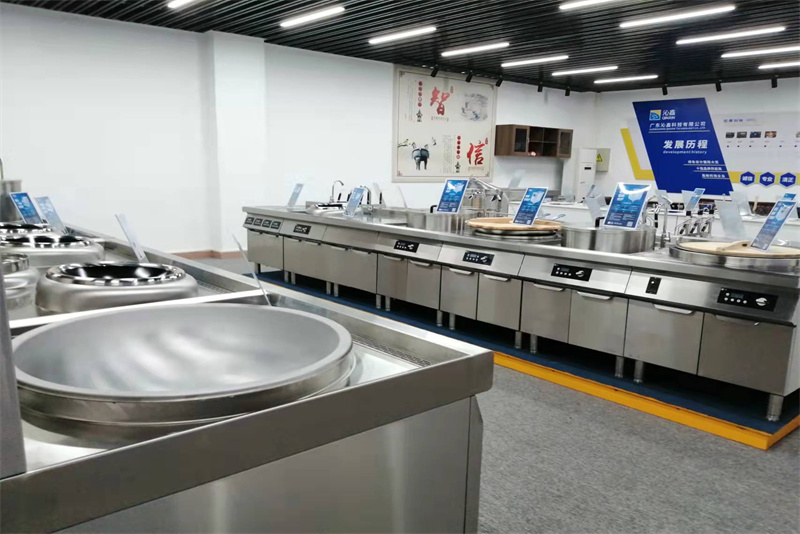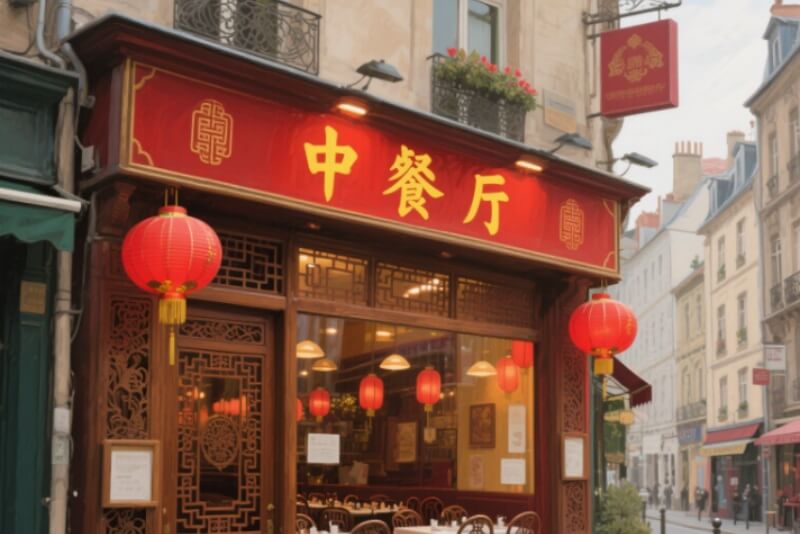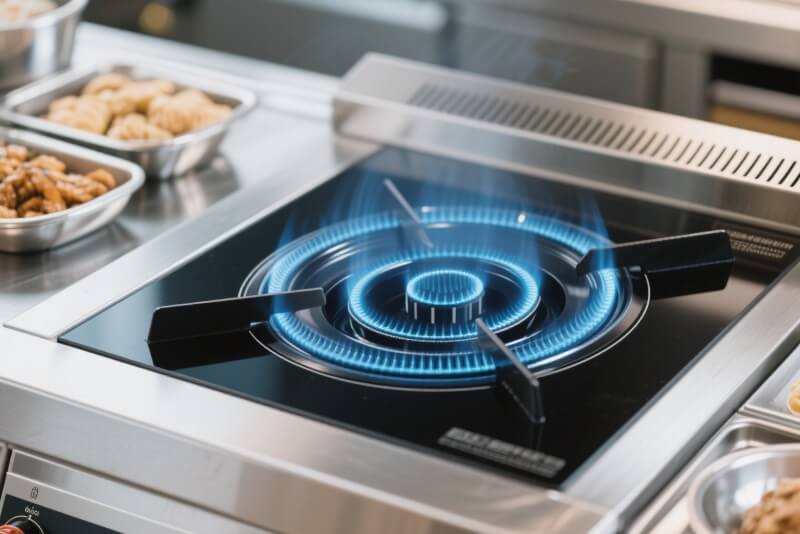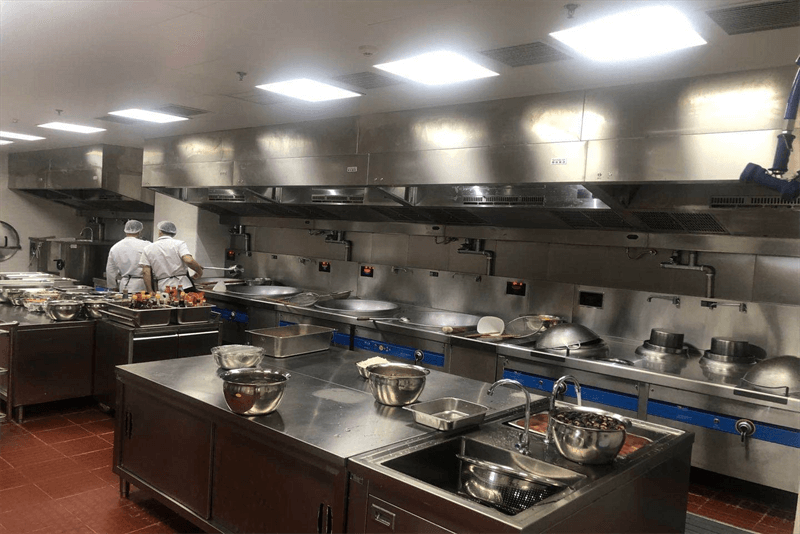Opening a Chinese restaurant in Europe presents many opportunities and challenges. To run the restaurant…

A Complete Guide to Purchasing Commercial Induction Cookers for Restaurant Owners, Dealers, and Chain Brands
At a time when the catering industry is booming, commercial induction cookers are core kitchen equipment. Their performance and quality are directly related to the quality of dishes, energy costs, and kitchen work efficiency. Whether it is an independently operated restaurant owner, a stove dealer for the catering market, or a chain restaurant pursuing standardization and scale, accurately purchasing a suitable commercial induction cooker is a crucial decision-making link.
This article will deeply analyze the key considerations of different entities when purchasing commercial induction cookers, as well as how to find high-quality manufacturers, balance quality and price, and understand market hot sales trends. At the same time, it will provide detailed guidance for cross-border procurement.
I. Core Considerations of Manufacturers and Products
1. Manufacturer Strength Assessment
(1) Brand Reputation and Word of Mouth
In-depth research on the manufacturer’s brand history and check its reputation in the industry. Companies that have long focused on the research, development, and production of commercial induction cookers often have accumulated rich technical experience and user feedback, which can ensure that their products are stable and reliable.
For example, some brands that have been established for more than ten years and have won numerous awards at catering equipment exhibitions have products that have been tested in the market for a long time and are more trustworthy.
Check online and offline user reviews, including feedback from restaurant practitioners, stove dealers, and other groups. Pay attention to key indicators such as the product’s failure rate in actual use and the response speed of after-sales service. Problems exposed by negative reviews may be potential risks.
(2) R&D and Innovation Capabilities
Understand whether the manufacturer has an independent R&D team and continues to invest in new technology research and development. For example, some advanced manufacturers have developed intelligent temperature control systems that can accurately adjust the temperature according to the cooking requirements of different dishes and improve the consistency of dish quality; some companies have developed energy-saving technologies to reduce energy consumption costs effectively.
Pay attention to the frequency of product updates and iterations, and keep up with industry development trends. For example, new commercial induction cookers use more efficient electromagnetic coil designs to improve energy conversion efficiency or are equipped with intelligent control systems to support remote monitoring and data statistics to meet the needs of modern kitchen intelligent management.
(3) After-sales Service Network
- Warranty policy: Does the manufacturer provide a 1 to 3-year warranty for core components?
- Response time: Need to confirm provincial service network coverage (recommended > 80%)
- Accessories supply: Inventory cycle of key components such as cable reels and IGBT modules
(4) Production Scale and Quality Control
Investigate the scale of the manufacturer’s production plant and the investment in automated production equipment. Large-scale automated production lines can ensure product consistency and high-precision assembly, reducing errors caused by manual operation. For example, high-precision patch production lines are used to install circuit components to ensure the stability of the induction cooker control board.
A strict quality control system guarantees product quality. Check whether the manufacturer has passed ISO9001 and other international quality management system certifications to understand the rigor of its raw material procurement, production process monitoring, and finished product testing.
For example, key components such as IGBT (insulated gate bipolar transistor) are strictly screened and aged to ensure the reliability of the induction cooker under high-load operation.
2. Key Product Indicators
(1) Power and Energy Efficiency
Choose the appropriate power according to the restaurant’s size and cooking needs. Small restaurants can choose 5-10 kW induction cookers to meet daily cooking, soup making, and other needs; large chain restaurant kitchens need to be equipped with 20-30 kW or even higher power equipment to cope with high-intensity, large-volume cooking tasks.
| Index | Reference Standards | Applicable scenarios |
| Power Range | 3.5 to 15KW | Fast food restaurants should choose 5 to 8 kW, large kitchens should choose 15 kW or more |
| Thermal Efficiency | ≥88% | Directly affects energy consumption costs (every 1% increase saves 300 yuan in electricity costs per year) |
| Temperature control accuracy | ±1℃ | French cuisine, molecular cuisine |
Energy efficiency rating is directly related to operating costs. Products with high energy efficiency ratings are preferred, as they have higher energy conversion efficiency and consume less electricity for the same cooking effect. For example, a commercial induction cooker with level 1 energy efficiency can save considerable electricity bills over the long term compared to a level 3 energy efficiency product.
(2) Safety Certification
Ensure that the product has passed the necessary safety certifications, such as CCC (China Compulsory Certification) and CE (European Union Compulsory Certification). These certifications indicate that the product meets strict safety standards and has reliable guarantees in terms of electrical safety, electromagnetic compatibility, etc.
- International certifications: CE (EU), UL (North America), SAA (Australia)
- Chinese qualifications: ISO9001 quality management system, CCC (China market access)
- Special testing: electromagnetic compatibility (EMC) test report, energy efficiency rating certificate
Pay attention to additional safety protection features, such as overheating protection, overcurrent protection, waterproof and dustproof design, etc. The kitchen environment is complex, with a lot of water vapor and oil pollution. Good protection design can extend the service life of the induction cooker and reduce the risk of failure.
(3) Controllability and Intelligence
The control interface should be simple and intuitive so that chefs can quickly get started. Different control methods, such as touch buttons and knob adjustments, have their advantages and disadvantages and should be selected according to the operating habits of the kitchen staff. For example, touch buttons are easy to clean, but there may be a risk of accidental touch; knob adjustments are more user-friendly and suitable for chefs who are used to traditional stoves.
Intelligent functions can improve kitchen efficiency and food quality. For example, with preset recipe programs, chefs only need to select the corresponding dishes, and the induction cooker will automatically adjust the power and temperature; the timed cooking function can achieve precise heat control; the fault self-diagnosis system can detect and prompt faults in time for quick maintenance.
5. Function Configuration
Intelligent protection (dry burning alarm, voltage overload protection, leakage detection); operation interface (waterproof level>IPX4, anti-accidental touch design); expansion interface (IoT module is suitable for remote monitoring of chain restaurants)
-
 Tabletop Automatic Wok Cooking Machine for Restaurant Kitchen LT-CD300T-C205
Tabletop Automatic Wok Cooking Machine for Restaurant Kitchen LT-CD300T-C205 -
 Tabletop Automatic Stir-frying Wok Machine for Restaurant LT-CD300T-C105
Tabletop Automatic Stir-frying Wok Machine for Restaurant LT-CD300T-C105 -
 Industrial Automatic Wok Cooking Machine Stir-Fryer LT-CD700T4-D130
Industrial Automatic Wok Cooking Machine Stir-Fryer LT-CD700T4-D130 -
 Automatic Robotic Wok Cooking Machine for Restaurant Canteen LT-CD300L-A205
Automatic Robotic Wok Cooking Machine for Restaurant Canteen LT-CD300L-A205 -
 Countertop Commercial Gas Automatic Fried Rice Machine LT-TGD36R
Countertop Commercial Gas Automatic Fried Rice Machine LT-TGD36R -
 Automatic Cooking 6 Burners Commercial Induction Cooker LT-B300VI-E235
Automatic Cooking 6 Burners Commercial Induction Cooker LT-B300VI-E235 -
 LT-CJ550-D208 Ming Stall Komerční automatický smažicí stroj Wok
LT-CJ550-D208 Ming Stall Komerční automatický smažicí stroj Wok -
 Průmyslový elektrický automatický míchací guláš Wok LT-XC80
Průmyslový elektrický automatický míchací guláš Wok LT-XC80 -
 Robot na vaření s automatickou fritézou LT-GD36/9 pro velké zatížení
Robot na vaření s automatickou fritézou LT-GD36/9 pro velké zatížení
II. Ways to Find High-Quality Manufacturers
1. Industry Exhibitions and Seminars
Participate in well-known domestic and foreign catering equipment exhibitions, such as the Shanghai International Hotel Supplies and Catering Expo and the Cologne International Food Technology Exhibition in Germany. These exhibitions bring together the world’s top commercial induction cooker manufacturers, where you can directly compare products of different brands, communicate with manufacturers face-to-face, and learn about the latest technologies and product advantages.
Pay attention to industry seminars and technical forums. Experts share industry dynamics, technology trends, and recommendations for high-quality manufacturers, which can provide valuable information references. At the same time, you can get to know industry insiders, expand your network resources, and obtain more manufacturer information on these occasions.
2. Network Platforms and Social Media
Use B2B e-commerce platforms, such as Alibaba International Station and Global Sources, to search for commercial induction cooker suppliers. Preliminary screening of potential high-quality manufacturers can be done by checking the supplier’s company information, product display, customer reviews, etc. However, it is necessary to pay attention to the authenticity of the information to avoid falling into the trap of false propaganda.
Pay attention to the manufacturer’s official website and social media account. The official website usually displays core information such as a detailed introduction of the company, product series, technical parameters, and success stories; social media accounts publish company dynamics, new product releases, user interactions, etc., which can provide insights into the vitality of the company and user reputation.
3. Supplier Evaluation Model
(1) Comprehensive Score
Comprehensive score = technical capability (40%) + price competitiveness (30%) + service capability (20%) + cooperation cases (10%)
(2) Key Points for Visiting the Factory
Production line automation level, quality inspection process (aging test, load impact test), raw material library (Infineon IGBT)
3. Dealer and Peer Recommendation
Establish a good relationship with local stove dealers. With their rich market experience and customer resources, they can recommend reputable and high-quality manufacturers. Based on long-term cooperation and after-sales feedback, dealers have a deep understanding of the advantages and disadvantages of manufacturers, and their recommendations have a high reference value.
Consult restaurant owners and purchasing managers of chain catering companies in the same industry to understand the brands of commercial induction cookers they use and their experience. Sharing successful cases can provide product performance in actual usage scenarios and help determine whether the product is suitable for their own needs.
III. Quality and Price Trade-off Strategy
1. Quality Cost Analysis
Recognize the long-term relationship between quality and cost. Although the initial purchase cost of a high-quality commercial induction cooker is high, its long-term operating cost is lower due to its stability, long life, and energy-saving characteristics.
For example, a high-quality induction cooker has a low failure rate, which reduces maintenance costs and downtime losses; it has a significant energy-saving effect, reduces electricity bills, and is more cost-effective in comprehensive calculations.
(1) Cost Accounting Formula
Life cycle cost = purchase cost + (annual power consumption * electricity price * service life) + maintenance cost
| Model | Purchase price | Annual electricity bill | Total cost over 5 years |
| A Brand ( Ordinary) | 8000 | 4200 | 8000+21000=29000 |
| B Brand ( High Efficiency) | 12000 | 3000 | 12000+15000=27000 |
(2) Cost of Key Components
Evaluate the quality and cost of key components. For example, for core components such as IGBT and capacitors, choose an induction cooker with well-known brands and high-quality components. Although the price is slightly higher, it can ensure the reliability of the induction cooker under high load and long-term operation, avoiding the risk of losing more than the smaller one.
| Component | Cost ratio | Quality Standards |
| IGBT | 25% to 35% | Infineon Technologies, Mitsubishi Electric |
| Ceramic Glass Panel | 15% to 20% | German SCHOTT, CERAN glass-ceramics |
2. Price Comparison and Negotiation Skills
Collect quotations from multiple manufacturers and compare product configurations, performance parameters, after-sales service, etc. Avoid making decisions based solely on price, but consider the cost-effectiveness comprehensively. For example, brand A is slightly more expensive but provides more complete after-sales service and quality assurance; brand B is cheaper, but the quality of key components is questionable, so it needs to be carefully weighed.
Negotiate prices with manufacturers and use skills to strive for more favorable prices. For example, you can ask for discounts for bulk purchases; long-term cooperation commitments can be exchanged for price concessions, and point out product deficiencies or competitive advantages to prompt manufacturers to adjust prices. At the same time, pay attention to manufacturers’ promotional activities and seasonal price fluctuations to seize purchasing opportunities.
IV. Market Insights and Product Selection of Stove Distributors
1. Market Demand Research
Analyze the local catering market structure, including restaurant types (Chinese, Western, fast food, etc.), scale distribution, cooking characteristics, etc. Different catering formats have significant differences in demand for commercial induction cookers. For example, Chinese restaurants focus on high-temperature stir-frying performance, while Western restaurants have higher requirements for precise temperature control.
Through questionnaire surveys and interviews with local restaurant owners and chefs, we can understand their satisfaction with existing induction cookers, their expected improved functions, and their price range. We can master first-hand market demand information and provide an accurate basis for product selection.
2. Product Adaptability Judgment
Based on market demand, we can select suitable commercial induction cooker products. Consider whether the power range of the product covers the needs of local restaurants, whether the functional design fits the local cooking habits, such as whether it has a cooking mode suitable for local specialty dishes, and whether the appearance size is suitable for the restaurant kitchen layout.
Evaluate the differentiated competitive advantages of the product. In the fiercely competitive stove market, unique product features such as novel appearance design, innovative energy-saving technology, and complete after-sales service can help products stand out and attract more catering customers.
3. Profit Margin and Sales Potential Evaluation
Analyze the purchase cost and market price of commercial induction cookers of different brands and models, and calculate the profit margin. Select products with reasonable profit margins and market competitiveness to ensure that dealers make profits while providing customers with cost-effective products.
Combine market demand trends with product promotion strategies to estimate product sales potential. Focus on emerging technology products and products that comply with environmental protection and energy-saving policies. Their market prospects are often broader and can bring sustained business growth to dealers.
-
 Přenosná indukční fritéza se dvěma koši LT-TZL-B105
Přenosná indukční fritéza se dvěma koši LT-TZL-B105 -
 Stolní indukční vařič Wok se 2 hořáky LT-TPA-B135
Stolní indukční vařič Wok se 2 hořáky LT-TPA-B135 -
 Stolní indukční varná deska se 2 hořáky LT-TPP-B135
Stolní indukční varná deska se 2 hořáky LT-TPP-B135 -
 Celoskleněná komerční indukční varná deska LT-QPM-C335
Celoskleněná komerční indukční varná deska LT-QPM-C335 -
 Stolní indukční varné desky pro komerční použití 6 hořáků LT-TBZ300VI-B135
Stolní indukční varné desky pro komerční použití 6 hořáků LT-TBZ300VI-B135 -
 5000W indukční varná deska pro restaurace LT-TAM-B505
5000W indukční varná deska pro restaurace LT-TAM-B505 -
 Stolní indukční varná deska pro restaurace 3500W LT-TPM-B535
Stolní indukční varná deska pro restaurace 3500W LT-TPM-B535 -
 3500W komerční indukční vařič LT-TPM-B135
3500W komerční indukční vařič LT-TPM-B135 -
 Stolní indukční varná deska se 4 hořáky 3500 W LT-TBZ300IV-B135
Stolní indukční varná deska se 4 hořáky 3500 W LT-TBZ300IV-B135
V. Key Points and Processes for Cross-border Procurement by Restaurant Owners
1. Precautions
(1) Certification and Standard Differences
Different countries and regions have different standards for the safety and electromagnetic compatibility of commercial induction cookers. For example, the EU’s CE certification and the US’s UL certification. Ensure that the purchased products comply with local regulations and standards. Otherwise, you may face the risk of being unable to use or return the products or even legal risks.
(2) Voltage and Frequency Adaptation
The voltage and frequency of foreign induction cookers may be different from those in China. It is necessary to confirm whether the product is compatible with the domestic power grid parameters. If they do not match, a suitable transformer or conversion equipment must be used; otherwise, the induction cooker may be damaged, or a safety accident may occur.
(3) After-sales Service Guarantee
Cross-border procurement and after-sales maintenance may be difficult. Priority should be given to foreign manufacturers that have local after-sales outlets or cooperate with local service providers. Understand the details, such as warranty scope, period, and supply of repair parts, to ensure long-term and stable use of the product.
2. Purchase Process
(1) Supplier Screening and Communication
Find high-quality foreign commercial induction cooker manufacturers through online platforms, exhibitions, and other channels, and send inquiries to understand product information, prices, delivery dates, etc. Use professional terms and clear expressions to ensure that both parties have a consistent understanding of product requirements and transaction terms.
(2) Contract Signing and Payment Method
Negotiate and sign a detailed contract with the supplier to clarify product specifications, quantity, price, delivery method, quality assurance, breach of contract liability, and other terms. Choose a safe and reliable payment method, such as a letter of credit (for large transactions) and PayPal (for small transactions), to ensure the safety of funds.
(3) Logistics and Customs Clearance
Arrange international logistics and transportation, select a professional freight forwarding company, and be responsible for cargo transportation, customs declaration, inspection, and other procedures. Please pay close attention to the status of cargo transportation to ensure that it arrives at the domestic port on time; cooperate with the customs clearance company to provide the required documents, pay customs duties, value-added tax, etc.; complete the customs clearance process, and successfully deliver the induction cooker to the restaurant.
Závěr
In short, whether you are a restaurant owner, stove dealer, or chain restaurant, you need to comprehensively consider factors such as manufacturer strength, product performance, quality-price balance, and market demand adaptability when purchasing commercial induction cookers. Only through in-depth research, accurate judgment, and reasonable decision-making can you choose a suitable commercial induction cooker to help the catering business develop efficiently, stably, and sustainably.
Although cross-border procurement faces many challenges, following standardized processes and paying attention to key details can also obtain high-quality products and inject new vitality into restaurant kitchens.
automatický stroj na vaření automatické varné stroje bbq chip fryer commercial cooking equipment commercial drop in induction cooker commercial food steamer commercial induction cooker commercial induction cooktop komerční indukční fritéza commercial induction fryer commercial induction hob commercial induction soup cooker Komerční indukční parní vařič commercial induction wok cooker komerční kuchyně cookware food steamer hob indukční vařič induction cookware INDUCTION FRYER induction grill induction hob iron wok kitchen equipment repair guide restaurangt equipment restaurant equipment stainless steel cookware user's guidance



0 komentářů k zobrazení